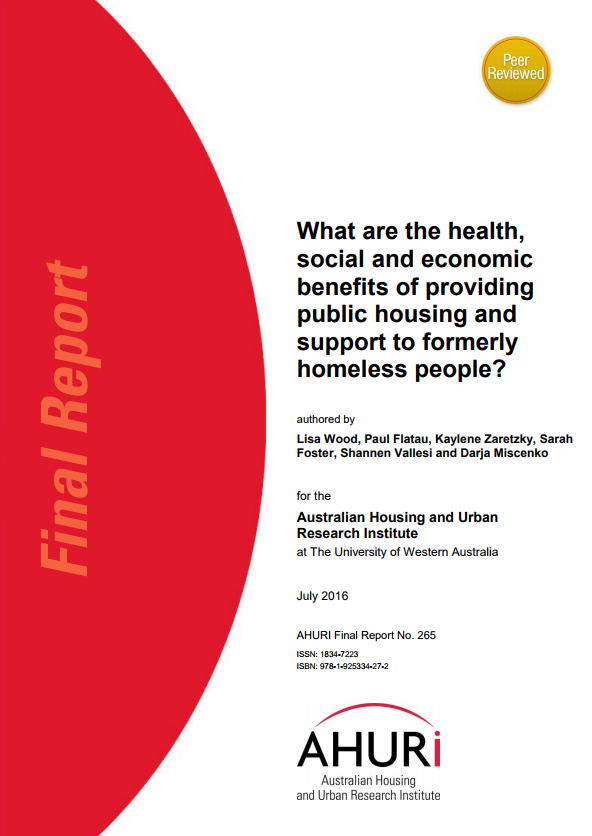Reports Database:
What are the health, social and economic benefits of providing public housing and support to formerly homeless people?

This report addresses the question of whether health service use and health service costs fall as a consequence of supported entry to public housing for formerly homeless people and those at risk of homelessness. It also examines the health and social outcomes of formerly homeless and at-risk of homelessness tenants.
An important benefit of the present study compared with previous Australian studies is the use of linked housing and health administrative data. The large sample size increases confidence in the findings presented because a larger number of clients and experiences are able to be investigated and the rigour of statistical analysis is improved.
The study links Western Australian person-level health service system records with person-level public housing tenancy records and tracks the health service use patterns of 983 NPAH and 2,400 priority housing (homelessness) tenants before entry into housing and following entry into housing. On the basis of the linked health and housing data in Western Australia, our study finds that the provision of public housing for NPAH program participants as well as those entering public housing through priority housing (homelessness) was associated with reduced health service use (both in the proportion using services as well as frequency/duration of use) in the year following entry into public housing as compared with the year prior to entry.
In particular, significant reductions were evident, pre- and post-entry into public housing, in the proportion of NPAH program and priority housing (homelessness) tenants accessing an Emergency Department (ED), an Intensive Care Unit (ICU), or psychiatric service or mental health provider, staying overnight in a hospital, or having a prescription for opioid dependence. There was no significant change for hospital in the home (HITH) services. Reductions in the frequency of visits to an ED or ICU, the duration of time spent in hospital, in psychiatric care or with a mental health service provider and the mean number of prescriptions for opioid dependence were also observed, with only an increase, post-entry into public housing in average days per person/per year utilising HITH services.
This study also provides an estimate of the potential economic impact of the change in health service use associated with provision of public housing and NPAH program support for homeless people and those at risk of homelessness. The overall decrease in frequency and duration of health service use, comparing the year prior to and the year following entry into a public housing tenancy, results in a combined potential health system cost saving in Western Australia of $16.4 million per year or $4,846 per person per year. If priority homeless clients are excluded; the change per person with NPAH support is nearly triple this at $13,273 per person per year. The large cost offset is primarily related to reduced health service use among clients of the NPAH Mental Health program, where potential health savings amount to $84,135 per person per year. Across all NPAH programs, the change in stays in hospital ($3,114 per person per year) and in psychiatric care ($1,558 per person per year) account for the vast majority of potential health cost savings.
The average cost of providing support under the NPAH programs examined is estimated as $6,462 per person per year (2009–12). This is less than half the potential health cost offsets associated with the NPAH programs ($13,273 per person per year (2012–13)). In particular, the large estimated health cost offset associated with the NPAH Mental Health program ($84,135 per person per year) suggests a large potential positive impact on government budgets is associated with this program. Cost savings of the kind identified in the present study are presently not identified in government budgets. The estimated cost savings simply accrue to the health service system and result in more needs being met in the health care system than would otherwise be the case. In short, more resources are freed up in the health system to meet health needs because of a successful housing and homelessness program.
